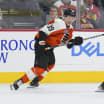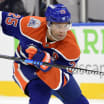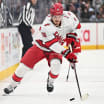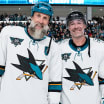Unmasked: Shesterkin emulating Vasilevskiy for Rangers in Eastern Final
Shows similarities with fellow Russia-born goalie while opposing him, Lightning
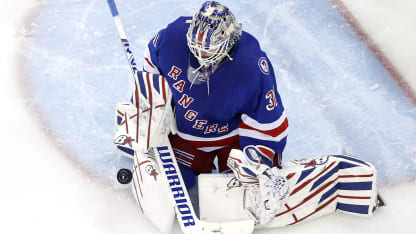
Vasilevskiy, voted the 2019 winner of the Vezina Trophy as the best goalie in the NHL and a finalist the past four seasons, and Shesterkin, the Vezina favorite this season, are opposing each other in the Eastern Conference Final.
Shesterkin got the better of the goalie he has taken after in Game 1 on Wednesday when the Rangers won 6-2. Game 2 of the best-of-7 series is at New York on Friday (8 p.m. ET; ESPN, ESPN+, CBC, SN, TVAS).
Marko Torenius worked with Shesterkin as a goaltending coach during his five seasons playing for SKA St. Petersburg in the Kontinental Hockey League. Though unaware of any direct links in the training history of the two goalies, Torenius says he sees elements of Vasilevskiy's style in Shesterkin's game.
Torenius said that's to be expected and that he believes most Russian goalies mimicked some of Vasilevskiy's traits while the 27-year-old was becoming the best goalie in the world, winning the Vezina in 2019, the Conn Smythe Trophy voted as Stanley Cup Playoff MVP in 2021, and the Stanley Cup with Tampa Bay the past two seasons.
"For sure there is common elements," Torenius said. "Russian goalies have been looking up to Vasilevskiy and they have been copying or picking up things from his game."
RELATED: [Complete Rangers vs. Lightning series coverage]
Among the similarities Torenius lists is a good command of "box control," a phrase born in Sweden to describe a goalie's ability to understand that for the puck to end up in the 6-foot-by-4-foot net behind him, it has to pass through a much smaller rectangle in front of him.
Neither Vasilevskiy nor Shesterkin wastes movement or energy chasing plays outside that danger area. Each is good at closing on pucks in that smaller space in front rather than opening to chase pucks in less dangerous areas.
Torenius also sees similarities in how each goalie uses a higher stance, with feet narrowed underneath, to look over traffic or monitor play on the perimeter of the zone, as well as in how each engages his hands when threats develop.
"High stance [and] hands wide, and it is more of outside-in movement with the hands if the shot comes," said Torenius, who credits Rashit Davydov, the other goaltending coach at SKA, for his movement work with Shesterkin. "In Russia, most guys copied that from Vasilevskiy."
Lateral quickness is another staple the two goalies share. Though skating skill is a hallmark of most Russia-trained goalies, there are differences in how Vasilevskiy and Shesterkin get across the ice so fast.
Vasilevskiy, who was 39-18-5 with a 2.49 goals-against average and .916 save percentage in 63 regular-season starts, is about explosive pushes and an ability to generate that power even from extended positions. His flexibility allows him to build vertical coverage, maintaining active hands in extended positions that would leave most goalies spread out and falling forward.
Vasilevskiy also moves well from his knees. From that position, he is good at using his lead-side skate to turn himself into the proper angle while making pushes, a departure from the traditional method of rotating by twisting while loading the outside leg to drive that push.
But Shesterkin, who was 36-13-4 with a 2.07 GAA and .935 save percentage in 53 regular-season games (52 starts), may have taken those movements to another level.
"Igor's got his own really easy-looking footwork that is so quick and smooth," Torenius said.
The quick, smooth nature of Shesterkin's movements was on display with 4:48 left in the first period of Game 1. Down on his post with the puck behind the net, Shesterkin calmly slid past the top of the crease, squared up, and was in the right position to deny Lightning forward Nikita Kucherov on a prime scoring opportunity from low in the left face-off circle.
Each goalie's skating fundamentals are strong, but it is Shesterkin's precision and fluidity, and his patience while holding his edges and playing on his skates, that mostly set the 26-year-old apart from the player he emulates.
"I don't feel that they play the same way at all," said former NHL goalie Steve Valiquette, a Rangers studio analyst for MSG Networks. He often works with former teammate Henrik Lundqvist, who retired after last season and holds many New York records for a goalie.
"Shesterkin plays more on his feet," Valiquette said, "and Lundqvist keeps saying [Shesterkin] is not even getting tired because he plays with such a relaxed stance."
This allows Shesterkin to beat passes without a lot of up-and-down movement, which makes it easier to survey the developing play. He tends to arrive early to his spot and make great reads as a result.
Valiquette cited a save against Carolina Hurricanes forward Nino Niederreiter late in the first period of Game 6 during the second round. Again, Shesterkin powered from his post to the top of the crease quickly on a pass from behind the net when he noticed Niederreiter lurking in a danger area even after the Rangers coverage lost the forward.
"So the pass comes and he explodes into the shooting lane," Valiquette said. "'Hank' and I are up in the [press] box together and I'm grabbing Hank's arm and we're kind of laughing and looking at each other like, 'That's a ridiculous read, right?' But all the work that he does beforehand and the fact that he's on his feet there allows him to make it."
Generally, Vasilevskiy would approach a similar play from his knees, just as he did on the goal Filip Chytil scored from the left hash marks to make it 3-2 midway through the second period of Game 1. There was more puck movement behind the net, making the read more difficult than the one Shesterkin made against Niederreiter.
For two of the best goalies in the world, it's those subtle differences that could play a role in deciding this series, even if their similarities are also a big part of why they've reached the pinnacle of their profession.






